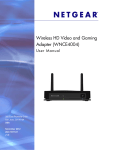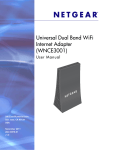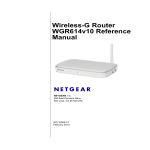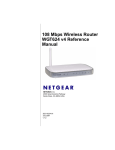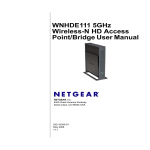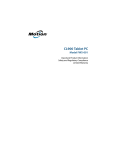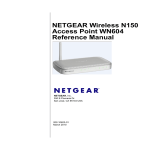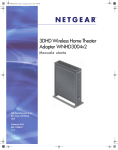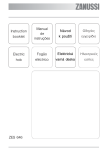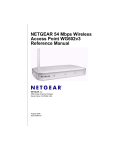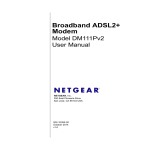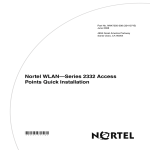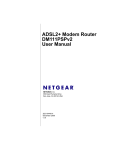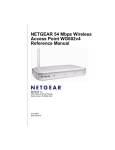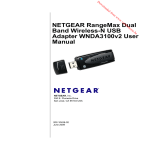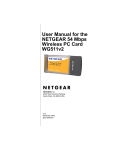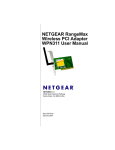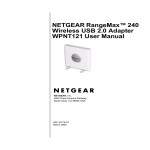Download Netgear WNHD3004 User Guide
Transcript
3DHD Home Theater Adapter WNHD3004 User Manual NETGEAR, Inc. 350 East Plumeria Drive San Jose, CA 95134 USA 202-10624-02 November 2010 v1.0 © 2010 by NETGEAR, Inc. All rights reserved. Product Registration, Support, and Documentation Register your product at http://www.netgear.com/register. Registration is required before you can use our telephone support service. Product updates and Web support are always available at http://www.netgear.com/support. Setup documentation is available on the support website and on the documentation website. When the wireless bridge is connected to the Internet, click the Knowledge Base or the Documentation link under Web Support on the main menu to view support information. Trademarks NETGEAR and the NETGEAR logo are registered trademarks of NETGEAR. Inc. in the United States and/or other countries. Microsoft, Windows, and Windows NT are registered trademarks and Windows Vista is a trademark of Microsoft Corporation. Other brand and product names are registered trademarks or trademarks of their respective holders. Statement of Conditions In the interest of improving internal design, operational function, and/or reliability, NETGEAR reserves the right to make changes to the products described in this document without notice. NETGEAR does not assume any liability that may occur due to the use or application of the product(s) or circuit layout(s) described herein. Certificate of the Manufacturer/Importer It is hereby certified that the 3DHD Home Theater Adapter WNHD3004 has been suppressed in accordance with the conditions set out in the BMPT-AmtsblVfg 243/1991 and Vfg 46/1992. The operation of some equipment (for example, test transmitters) in accordance with the regulations may, however, be subject to certain restrictions. Please refer to the notes in the operating instructions. Federal Office for Telecommunications Approvals has been notified of the placing of this equipment on the market and has been granted the right to test the series for compliance with the regulations. Bestätigung des Herstellers/Importeurs Es wird hiermit bestätigt, daß das 3DHD Home Theater Adapter WNHD3004 gemäß der im BMPT-AmtsblVfg 243/ 1991 und Vfg 46/1992 aufgeführten Bestimmungen entstört ist. Das vorschriftsmäßige Betreiben einiger Geräte (z.B. Testsender) kann jedoch gewissen Beschränkungen unterliegen. Lesen Sie dazu bitte die Anmerkungen in der Betriebsanleitung. Das Bundesamt für Zulassungen in der Telekommunikation wurde davon unterrichtet, daß dieses Gerät auf den Markt gebracht wurde und es ist berechtigt, die Serie auf die Erfüllung der Vorschriften hin zu überprüfen. Regulatory Compliance Information This section includes user requirements for operating this product in accordance with National laws for usage of radio spectrum and operation of radio devices. Failure of the end-user to comply with the applicable requirements may result in unlawful operation and adverse action against the end-user by the applicable National regulatory authority. ii v1.0, November 2010 Europe – EU Declaration of Conformity Marking by the above symbol indicates compliance with the Essential Requirements of the R&TTE Directive of the European Union (1999/5/EC). This equipment meets the following conformance standards: EN300 328, EN301 489-17, EN60950 A printed copy of the EU Declaration of Conformity certificate for this product is provided in the WNHD3004 product package. Europe – Declaration of Conformity in Languages of the European Community Cesky [Czech] NETGEAR Inc. tímto prohlašuje, že tento Radiolan je ve shode se základními požadavky a dalšími príslušnými ustanoveními smernice 1999/5/ES. Dansk [Danish] Undertegnede NETGEAR Inc. erklærer herved, at følgende udstyr Radiolan overholder de væsentlige krav og øvrige relevante krav i direktiv 1999/5/EF. Deutsch [German] Hiermit erklärt NETGEAR Inc., dass sich das Gerät Radiolan in Übereinstimmung mit den grundlegenden Anforderungen und den übrigen einschlägigen Bestimmungen der Richtlinie 1999/5/EG befindet. Eesti [Estonian] Käesolevaga kinnitab NETGEAR Inc. seadme Radiolan vastavust direktiivi 1999/5/EÜ põhinõuetele ja nimetatud direktiivist tulenevatele teistele asjakohastele sätetele. English Hereby, NETGEAR Inc., declares that this Radiolan is in compliance with the essential requirements and other relevant provisions of Directive 1999/5/EC. Español [Spanish] Por medio de la presente NETGEAR Inc. declara que el Radiolan cumple con los requisitos esenciales y cualesquiera otras disposiciones aplicables o exigibles de la Directiva 1999/5/CE. ÅëëçíéêÞ [Greek] ÌÅ ÔÇÍ ÐÁÑÏÕÓÁ NETGEAR Inc. ÄÇËÙÍÅÉ ÏÔÉ Radiolan ÓÕÌÌÏÑÖÙÍÅÔÁÉ ÐÑÏÓ ÔÉÓ ÏÕÓÉÙÄÅÉÓ ÁÐÁÉÔÇÓÅÉÓ ÊÁÉ ÔÉÓ ËÏÉÐÅÓ Ó×ÅÔÉÊÅÓ ÄÉÁÔÁÎÅÉÓ ÔÇÓ ÏÄÇÃÉÁÓ 1999/5/ÅÊ. Français [French] Par la présente NETGEAR Inc. déclare que l'appareil Radiolan est conforme aux exigences essentielles et aux autres dispositions pertinentes de la directive 1999/5/CE. Italiano [Italian] Con la presente NETGEAR Inc. dichiara che questo Radiolan è conforme ai requisiti essenziali ed alle altre disposizioni pertinenti stabilite dalla direttiva 1999/5/CE. Latviski [Latvian] Ar šo NETGEAR Inc. deklarç, ka Radiolan atbilst Direktîvas 1999/5/EK bûtiskajâm prasîbâm un citiem ar to saistîtajiem noteikumiem. Lietuviø [Lithuanian] Šiuo NETGEAR Inc. deklaruoja, kad šis Radiolan atitinka esminius reikalavimus ir kitas 1999/5/EB Direktyvos nuostatas. Nederlands [Dutch] Hierbij verklaart NETGEAR Inc. dat het toestel Radiolan in overeenstemming is met de essentiële eisen en de andere relevante bepalingen van richtlijn 1999/5/EG. iii v1.0, November 2010 Malti [Maltese] Hawnhekk, NETGEAR Inc., jiddikjara li dan Radiolan jikkonforma mal-htigijiet essenzjali u ma provvedimenti ohrajn relevanti li hemm fid-Dirrettiva 1999/5/EC. Magyar [Hungarian] Alulírott, NETGEAR Inc. nyilatkozom, hogy a Radiolan megfelel a vonatkozó alapvetõ követelményeknek és az 1999/5/EC irányelv egyéb elõírásainak. Polski [Polish] Niniejszym NETGEAR Inc. oœwiadcza, ¿e Radiolan jest zgodny z zasadniczymi wymogami oraz pozosta³ymi stosownymi postanowieniami Dyrektywy 1999/5/EC. Português [Portuguese] NETGEAR Inc. declara que este Radiolan está conforme com os requisitos essenciais e outras disposições da Directiva 1999/5/CE. Slovensko [Slovenian] NETGEAR Inc. izjavlja, da je ta Radiolan v skladu z bistvenimi zahtevami in ostalimi relevantnimi doloèili direktive 1999/5/ES. Slovensky [Slovak] NETGEAR Inc. týmto vyhlasuje, _e Radiolan spåòa základné po_iadavky a všetky príslušné ustanovenia Smernice 1999/5/ES. Suomi [Finnish] NETGEAR Inc. vakuuttaa täten että Radiolan tyyppinen laite on direktiivin 1999/5/EY oleellisten vaatimusten ja sitä koskevien direktiivin muiden ehtojen mukainen. Svenska [Swedish] Härmed intygar NETGEAR Inc. att denna Radiolan står I överensstämmelse med de väsentliga egenskapskrav och övriga relevanta bestämmelser som framgår av direktiv 1999/5/EG. Íslenska [Icelandic] Hér með lýsir NETGEAR Inc. yfir því að Radiolan er í samræmi við grunnkröfur og aðrar kröfur, sem gerðar eru í tilskipun 1999/5/EC. Norsk [Norwegian] NETGEAR Inc. erklærer herved at utstyret Radiolan er i samsvar med de grunnleggende krav og øvrige relevante krav i direktiv 1999/5/EF. FCC Requirements for Operation in the United States FCC Information to User This product does not contain any user serviceable components and is to be used with approved antennas only. Any product changes or modifications will invalidate all applicable regulatory certifications and approvals. FCC Guidelines for Human Exposure This equipment complies with FCC radiation exposure limits set forth for an uncontrolled environment. This equipment should be installed and operated with minimum distance of 20 cm between the radiator and your body. This transmitter must not be co-located or operated in conjunction with any other antenna or transmitter. FCC Declaration Of Conformity We NETGEAR, Inc., 350 East Plumeria Drive, San Jose, CA 95134, declare under our sole responsibility that the model WNHD3004 3DHD Home Theater Adapter WNHD3004 complies with Part 15 of FCC Rules. Operation is subject to the following two conditions: • This device may not cause harmful interference, and iv v1.0, November 2010 • This device must accept any interference received, including interference that may cause undesired operation. FCC Radio Frequency Interference Warnings & Instructions This equipment has been tested and found to comply with the limits for a Class B digital device, pursuant to Part 15 of the FCC Rules. These limits are designed to provide reasonable protection against harmful interference in a residential installation. This equipment uses and can radiate radio frequency energy and, if not installed and used in accordance with the instructions, may cause harmful interference to radio communications. However, there is no guarantee that interference will not occur in a particular installation. If this equipment does cause harmful interference to radio or television reception, which can be determined by turning the equipment off and on, the user is encouraged to try to correct the interference by one or more of the following methods: • Reorient or relocate the receiving antenna. • Increase the separation between the equipment and the receiver. • Connect the equipment into an electrical outlet on a circuit different from that which the radio receiver is connected. • Consult the dealer or an experienced radio/TV technician for help. 3DHD Home Theater Adapter WNHD3004 Tested to Comply with FCC Standards FOR HOME OR OFFICE USE Modifications made to the product, unless expressly approved by NETGEAR, Inc., could void the user's right to operate the equipment. Caution to Canada users High power radars are allocated as primary users (meaning they have priority of 5250-5350 MHz and 5650-5850 MHz and these radars could cause interference and/or damage to LELAN devices. Operation is subject to the following two conditions: 1) This device may not cause interference and 2) This device must accept any interference, including interference that may cause undesired operation of the device. IMPORTANT NOTE IC Radiation Exposure Statement: This equipment complies with IC radiation exposure limits set forth for an uncontrolled environment. End users must follow the specific operating instructions for satisfying RF exposure compliance. This equipment should be installed and operated with minimum distance 20CM between the radiator and your body. This transmitter must not be co-located or operated in conjunction with any other antenna or transmitter. Maximum Wireless Signal Rate Derived from IEEE Standard 802.11 Specifications Actual data throughput will vary. Network conditions and environmental factors, including volume of network traffic, building materials and construction, and network overhead, lower actual data throughput rate. v v1.0, November 2010 Product and Publication Details Model Number: WNHD3004 Publication Date: November 2010 Product Family: Wireless-N Bridge Product Name: 3DHD Home Theater Adapter WNHD3004 Home or Business Product: Home Language: English Publication Part Number: 202-10624-02 vi v1.0, November 2010 Contents Chapter 1 Getting Started Unpacking Your New Home Theater Adapter .................................................................1-1 Product Label ...........................................................................................................1-2 LED Description .......................................................................................................1-2 Back Panel Connectors, Buttons, and Switches ......................................................1-3 Positioning Your Unit ......................................................................................................1-4 Chapter 2 Setting Up Your Wireless Network What If Some of My Devices Do Not Support WPS? .....................................................2-1 Access Point Mode WPS Setup .....................................................................................2-2 WPS Push Button Client Setup ................................................................................2-3 Setting Up Two WNHD3004 Units ..................................................................................2-5 Setting Up Two WNHD3004 Units at Once ..............................................................2-5 Adding an Additional WNHD3004 to Your Network Later ........................................2-5 Connecting Other Devices to a WNHD3004 ..................................................................2-7 Chapter 3 Connecting to the WNHD3004 Connecting to Your WNHD3004 ..............................................................................3-1 Using Firmware Update ...........................................................................................3-2 Chapter 4 Wireless Security Choosing Appropriate Wireless Security ........................................................................4-1 Changing Wireless Security Settings .............................................................................4-3 Viewing Basic Wireless Settings ..............................................................................4-3 Viewing Network Settings ...............................................................................................4-5 Configuring WPA Wireless Security .........................................................................4-6 Viewing Advanced Wireless Settings .............................................................................4-6 vii v1.0, November 2010 3DHD Home Theater Adapter WNHD3004 User Manual Using Push 'N' Connect (Wi-Fi Protected Setup) ...........................................................4-7 Push Button Configuration .......................................................................................4-8 Enabling a Wireless Client .......................................................................................4-9 Connecting Additional Wireless Client Devices after WPS Setup ..........................4-10 Restricting Wireless Access by MAC Address .............................................................4-10 Changing the Administrator Password .........................................................................4-12 Chapter 5 Customizing Your Wireless Network Using the Network Settings Options ...............................................................................5-1 Configuring the Access Point Parameters ...............................................................5-2 Using the DHCP Server ...........................................................................................5-3 Optimizing Wireless Performance ..................................................................................5-3 Chapter 6 Using Network Management Tools Viewing Status and Log Information ...............................................................................6-1 Backing Up Your Configuration .......................................................................................6-7 Managing the Configuration File .....................................................................................6-7 Backing Up and Restoring the Configuration ...........................................................6-7 Erasing the Configuration .........................................................................................6-8 Upgrading the Software ..................................................................................................6-8 Upgrading Automatically to New Software ...............................................................6-9 Chapter 7 Troubleshooting Troubleshooting Tips ......................................................................................................7-1 Troubleshooting Basic Functions ....................................................................................7-2 Troubleshooting the Web Configuration Interface ..........................................................7-3 Restoring the Default Configuration and Password ........................................................7-3 Appendix A Technical Specifications Default Configuration Settings ....................................................................................... A-1 Restoring the Default User Name and Password .......................................................... A-3 Appendix B Related Documents Index viii Contents v1.0, November 2010 Chapter 1 Getting Started The WNHD3004 is an Access Point/Bridge that by default runs in "Auto" mode. In this mode, it detects whether it has a wired connection to a router (with DHCP server). If it does, it automatically sets itself to "Access Point"(the top of the user interface screen displays "access point manager"). This takes about 30 –60 seconds. If no DHCP is detected through a wired connection, it sets itself to Bridge (Station) mode and the top of the user interface screen displays "bridge manager." This will take about 60 –90 seconds. In Auto mode, if no DHCP server is detected, it runs in Bridge mode. If the DHCP server is detected later, and this bridge is not connect to any Access Point (AP), it automatically switches to Access Point mode. By default the units run in DHCP client mode, which means the AP and Bridge (if connected to the AP) will both get DHCP IP addresses from the router. You must log in to the router’s configuration interface, find the DHCP IP addresses for both the AP and STA (Bridge) devices, and then connect to their user interfaces by browsing to their IP addresses. Unpacking Your New Home Theater Adapter Your product package should contain the following items: • Installation Guide • WNHD3004 unit • AC power adapter (varies by region) • Ethernet cable • Stand Keep the carton, including the original packing materials, in case you need to return the product for repair. 1-1 v1.0, November 2010 3DHD Home Theater Adapter WNHD3004 User Manual Product Label The product label for the 3DHD Wireless Home Theater Adapter looks like this: Figure 1 LED Description The lights on the front panel indicate the operating status of the bridge. Power LED Flashing green (fast) The unit is rebooting. Flashing green (slow) The unit is ready. For the AP, it means that no bridge or other client is connected to it; for the Bridge, it means that the bridge is not connected with any AP. Solid green The AP and the Bridge are associated. Wireless Speed LED AP: Solid green Off Bridge: Solid green Solid orange Solid red Off WPS Button Blinking blue Wireless function is on. AP has no STA (Bridge) associated with it. Wireless speed is at its best. Wireless speed is good. Wireless speed is very weak. Bridge is not associated with any AP. WPS in progress. Figure 1-1 1-2 Getting Started v1.0, November 2010 3DHD Home Theater Adapter WNHD3004 User Manual Back Panel Connectors, Buttons, and Switches This illustration identifies the connectors and switches on the back of the unit. Power connector On/Off button Factory Reset Settings Ethernet Ports Figure 1-2 Table 1-1. Connectors and Buttons Connector or Button Description Power connector Port for connecting the AC power adapter. Four Mbps Ethernet ports For connecting the unit using Ethernet cables to other equipment like switches, game consoles, media adapters, print servers, or a router. Factory default reset button Use a paper clip to press this button for about 10 seconds to reset the unit to its factory default settings. Mode switch settings • Auto. Auto is the factory default setting. In Auto mode, if the unit senses it is connected to a router or gateway, it automatically sets itself to run as an AP. Otherwise, if connected to any other wired device, the unit automatically sets itself to run in Bridge mode. • AP. When switched to AP (access point) mode, the unit acts as an access point. In this mode, connect it to a router. The free Ethernet port can be used to connect other equipment to your network using an Ethernet cable. • Bridge. In Bridge mode, connect devices to the unit using Ethernet cables and they will connect to your wireless network. Typically, when a unit is set to bridge mode, it is paired with a WNHD3004 working in AP mode. On/Off button Press this button to turn the WNHD3004 on or off. Getting Started 1-3 v1.0, November 2010 3DHD Home Theater Adapter WNHD3004 User Manual Positioning Your Unit The operating distance or range of your wireless connection can vary significantly depending on the physical placement of your unit. For example, the thickness and number of walls the wireless signal must pass through might limit the range. Note: Failure to follow these guidelines can result in significant performance degradation or an inability to wirelessly connect to the home theater adapter. For best results, place your WNHD3400: • Near the center of the area where your computers and other devices will operate, preferably within line of sight to your wireless devices. • Accessible to an AC power outlet and near Ethernet cables for other devices. • In an elevated location such as a high shelf, keeping the number of walls and ceilings between the wireless access point and your other devices to a minimum. • Away from any large metal surfaces, such as a solid metal door or aluminum studs. Large expanses of other materials such as glass, insulated walls, fish tanks, mirrors, brick, and concrete can also affect your wireless signal. • If placing two WNHD3004 devices with a direct line of sight between them, do not place them closer than 10 feet, as the antennas are tuned for this optimum distance. For information about connecting the WNHD3004 to a router or connecting a wireless device to the WNHD3004 Access Point, see “Access Point Mode WPS Setup” on page 2-2. 1-4 Getting Started v1.0, November 2010 Chapter 2 Setting Up Your Wireless Network This chapter describes how to easily and securely set up your home theater adapter using WPS (Wi-Fi Protected Setup). WPS is a standard for easy and secure setup of wireless home networks, created by the Wi-Fi Alliance and launched in January 2007. For more information about WPS, go to http://www.wi-fi.org/wifi-protected-setup. This chapter provides instructions for using the WPS push button. See Chapter 4, “Wireless Security” for other wireless setup and security options. Note: Only wireless devices that support the 5GHz 802.11n or the 802.11a standards can connect to the WNHD3004 Home Theater Adapter product. You cannot use the WNHD3004 with 802.11b/g devices. This chapter includes the following sections: • “What If Some of My Devices Do Not Support WPS?” • “Access Point Mode WPS Setup” on page 2-2 • “Setting Up Two WNHD3004 Units” on page 2-5 What If Some of My Devices Do Not Support WPS? Use this chart to identify the setup method you should use. My Wireless Devices Setup to Use Comment All my wireless devices support WPS. Use the WPS automated setup. This is the easiest and fastest way to set up very secure wireless. Some of my devices support WPS and some do not. Use the WPS automated setup for devices that support WPS. Then, manually configure the other devices to use the WPA security key. The default WPA security key can be retrieved from the WNHD3004 AP web interface. 2-1 v1.0, November 2010 3DHD Home Theater Adapter WNHD3004 User Manual Access Point Mode WPS Setup These instructions will guide you through connecting the WNHD3004 to a router. Then, you will connect wirelessly using WPS technology. Internet Router/gateway WNHD3004 Access Point Laptop with adapter like the NETGEAR WNDA3100 USB Adapter Figure 2-1 1. Connect the Ethernet cable from a LAN port on your existing router or gateway to an Ethernet port on the WNHD3004. 2. Connect the power adapter to the unit. Verify that the power light is on. Power light You are finished with setting up the access point. WPS button/ light 2-2 Setting Up Your Wireless Network v1.0, November 2010 3DHD Home Theater Adapter WNHD3004 User Manual WPS Push Button Client Setup 1. On the WNHD3004, press the NETGEAR Push 'N' Connect WPS push button. Figure 2-2 The WPS button blinks for no more than 2 minutes. Setting Up Your Wireless Network 2-3 v1.0, November 2010 3DHD Home Theater Adapter WNHD3004 User Manual 2. Within 2 minutes, activate the WPS push button feature on the other WNHD3004 units or on your wireless client computer. For example, using the NETGEAR WNDA3100 USB adapter, within the 2-minute period, click the picture of this button that the Smart Wizard displays. WPS button Figure 2-3 The WPS button on the WHD3004 blinks while the two devices are connecting and exchanging the security key. When the devices successfully connect, the WPS LED on the WHD3004 turns off. The Settings screen of the WHD3004 confirms your connection. On a NETGEAR adapter, you will notice on its Settings screen that WPS sent the security key from the access point to the USB adapter. In the future, you can add more WPS–enabled wireless devices to your network just as easily. Repeat this step for each additional WPS push button-enabled device you add to your network. You are done! It was just that easy to set up a secure wireless connection between the home theater adapter and your wireless computer. 2-4 Setting Up Your Wireless Network v1.0, November 2010 3DHD Home Theater Adapter WNHD3004 User Manual Setting Up Two WNHD3004 Units You can set up multiple WNHD3004 units, for example if you purchase them in the same package. Follow the instructions below. AP mode Bridge mode Gaming console Internet Router/gateway WNHD3004 WNHD3004 Digital media adapter Figure 2-4 Setting Up Two WNHD3004 Units at Once To set up two WNHD3004 devices: 1. Connect the Ethernet cable from a LAN port in the router or gateway to either LAN port on one home theater adapter. 2. Place the other home theater adapter near the media player, game console, or switch, and connect it with an Ethernet cable. 3. To complete installation, connect power adapters to one or more Wireless-N bridges. Allow a few minutes for your devices to connect to the Internet. Adding an Additional WNHD3004 to Your Network Later Home theater adapters, if purchased as a kit, are pre-configured to securely connect to each other automatically, according to the instructions in the previous section. To add another WNHD3004, simply use the WPS (Wi-Fi Protected Setup) push button. 1. Make sure that the WNHD3004 you are adding is set to Auto or Bridge mode but not set to AP mode, and place it near the devices you will connect to it. Setting Up Your Wireless Network 2-5 v1.0, November 2010 3DHD Home Theater Adapter WNHD3004 User Manual 2. Connect the power adapter. The Power light should blink in green. Figure 2-5 3. On the new WNHD3004, press the WPS button; its WPS light blinks. Within 2 minutes, press the WPS button on the existing Wireless-N bridge that is operating in AP mode. Its WPS light starts to blink. After 1–2 minutes the new unit in Bridge mode should be associated with the existing unit in AP mode. The WPS lights for the AP unit and the Bridge mode unit turn off. The Power lights on both units are steadily on. 2-6 Setting Up Your Wireless Network v1.0, November 2010 3DHD Home Theater Adapter WNHD3004 User Manual Connecting Other Devices to a WNHD3004 There are four ways you can connect other devices to the access point: • For wireless devices that support the WPS automated method, repeat the steps in the “WPS Push Button Client Setup” on page 2-3 for the WPS setup method. WPS will automatically transfer the security settings from the Wireless-N Access Point to the device you are adding. • For wireless devices that do not support WPS, manually configure them. Refer to the instructions in the product documentation of the wireless device you will add. The default wireless network name (SSID) is WNHD3400. • For wired devices, use an Ethernet cable to connect to an available Ethernet port on the WNHD3004. • Use the Setup Wizard. Figure 2-6 The Setup Wizard lets you use two wizards, one that guides you through connecting a wireless device to your Access Point, and another to help you with your wireless network setup. For the Bridge/Station, this screen has only one function: to set up its wireless settings to match it on the AP side, either through WPS, or through manual settings. Setting Up Your Wireless Network 2-7 v1.0, November 2010 3DHD Home Theater Adapter WNHD3004 User Manual 2-8 Setting Up Your Wireless Network v1.0, November 2010 Chapter 3 Connecting to the WNHD3004 This chapter describes how to connect to your WNHD3004 and keep its firmware up to date. You can use the Web Configuration Interface to manage your WNHD3004. This chapter includes: • “Connecting to Your WNHD3004” • “Using Firmware Update” on page 3-2 Connecting to Your WNHD3004 You can use a Web browser to log in to a WNHD3004 and view or change its settings. To access the Web Configuration Interface: 1. Depending on how your WNHD3004 is connected, do one of the following: a. If the WNHD300r is connected with an Ethernet cable, open the Web Configuration Interface by typing http://IP_address_of_the_device in the address field of your browser, and then pressing Enter. b. If your PC is directly connected to the WNHD3004, type either http://www.mywifiext.net or http://www.mywifiext.net in the address field of your browser, and then press Enter. 3-1 v1.0, November 2010 3DHD Home Theater Adapter WNHD3004 User Manual By default, the WNHD3004 in AP mode has a default IP address of 192.168.1 240, and the WNHD3004 in Bridge mode has a default IP address of 192.168.1 241. When the AP is connected to a router, both the AP and the Bridge receive dynamic IP addresses from the router. The login window opens: Figure 3-1 2. Enter admin for the user name and password for the password. If the unit is connected to the Internet, you can select Knowledge Base or Documentation under Web Support in the main menu to view support information or the user manual. If you do not click Logout, the unit waits for 5 minutes after no activity before it automatically logs you out. You can adjust this timeout setting on the Administrator Settings screen (from the main menu, select Tools, then Admin). Using Firmware Update Once logged in to the Web Configuration Interface, you can click the Check button on the Firmware screen to check for new firmware. If the update feature discovers a newer version of software, you are asked if you want to upgrade to the new software. 3-2 Connecting to the WNHD3004 v1.0, November 2010 3DHD Home Theater Adapter WNHD3004 User Manual Figure 3-2 3. To download and install a newer version, click Yes. The update feature automatically installs the most recent firmware. Warning: Do not turn off the home theater adapter, shut down the computer, or do anything else to the home theater adapter until the home theater adapter finishes upgrading! If no new firmware is available, the following message appears. Figure 3-3 Connecting to the WNHD3004 3-3 v1.0, November 2010 3DHD Home Theater Adapter WNHD3004 User Manual 3-4 Connecting to the WNHD3004 v1.0, November 2010 Chapter 4 Wireless Security The 3DHD Home Theater Adapter WNHD3004 provides highly effective security features, which are covered in detail in this chapter. This chapter includes the following sections: • “Choosing Appropriate Wireless Security” on page 4-1 • “Changing Wireless Security Settings” on page 4-3 • “Viewing Network Settings” on page 4-5 • “Viewing Advanced Wireless Settings” on page 4-6 • “Using Push 'N' Connect (Wi-Fi Protected Setup)” on page 4-7 • “Restricting Wireless Access by MAC Address” on page 4-10 • “Changing the Administrator Password” on page 4-12 Choosing Appropriate Wireless Security By default, the WNHD3004 bridges in the same package are pre-configured with wireless security with a unique network key (password) that is unique to the individual package, like its serial number. Unlike wired networks, wireless networks allow anyone with a compatible adapter to receive your wireless data transmissions well beyond your walls. Operating an unsecured wireless network creates an opportunity for outsiders to eavesdrop on your network traffic or to enter your network to access your computers and files. Indoors, computers can connect over 802.11n/a wireless networks at ranges of up to 500 feet. Such distances can allow for others outside your immediate area to access your network. Use the security features of your wireless equipment that are appropriate to your needs. The time it takes to establish a wireless connection can vary depending on both your security settings and device placement. Do not run an unsecured wireless network unless it is your intention to provide free Internet access for the public. 4-1 v1.0, November 2010 3DHD Home Theater Adapter WNHD3004 User Manual Wireless data security options Range: up to 500 foot radius 1) Open system: easy but no security 2) MAC access list: no data security WNHD3004 3) WPA-PSK: strong security 4) WPA2-PSK: very strong security Note: Use these with other features that enhance security (Table 4-2 on page 4-3). Figure 4-1 Basic security options are listed in order of increasing effectiveness in the following table. For more details on wireless security methods, click the link to the online document “Wireless Networking Basics” in Appendix B. Table 4-1. Wireless Security Options Security Type Description None. No wireless security. Recommended only for troubleshooting wireless connectivity. Do not run an unsecured wireless network unless it is your intention to provide free Internet access for the public. WPA2-PSK (AES). WPA-PSK (TKIP) + WPA2-PSK (AES). Mixed mode. For more information, see “Configuring WPA Wireless Security” on page 4-6. Wi-Fi Protected Access with Pre-Shared Key (WPA-PSK and WPA2PSK) data encryption provides extremely strong data security, very effectively blocking eavesdropping. 4-2 Wireless Security v1.0, November 2010 3DHD Home Theater Adapter WNHD3004 User Manual Table 4-2. Other Features That Enhance Security Security Type Description Turn off the broadcast of the wireless network name SSID. For more information, see “Viewing Advanced Wireless Settings” on page 4-6. If you disable the broadcast of the SSID, only devices that know the correct SSID can connect. This nullifies the wireless network discovery feature of some products such as Windows XP, but your data is still fully exposed to an intruder using available wireless eavesdropping tools. Restrict access based on MAC address. For more information, see “Restricting Wireless Access by MAC Address” on page 4-10. You can restrict access to only trusted devices so that unknown devices cannot wirelessly connect to the home theater adapter. MAC address filtering adds an obstacle against unwanted access to your network by the general public, but the data broadcast over the wireless link is fully exposed. This data includes your trusted MAC addresses, which can be read and impersonated by a hacker. Changing Wireless Security Settings This section describes the wireless settings that you can view and configure in the Wireless Settings screen, which you access under Setup in the main menu. Viewing Basic Wireless Settings To specify the wireless security settings of your WNHD3004: 1. Log in to the router as described in “Connecting to the WNHD3004” on page 3-1. 2. In the main menu under Basic, select Wireless Settings. Wireless Security 4-3 v1.0, November 2010 3DHD Home Theater Adapter WNHD3004 User Manual Figure 4-2 The available settings in this screen are: • Name (SSID). Enter a value of up to 32 alphanumeric characters. When more than one wireless network is active, different wireless network names provide a way to separate the traffic. For a wireless device to participate in a particular wireless network, it must be configured with the SSID for that network. The default SSID is WNHD3400. • Region. The default value is Europe in Europe and United States in the US. • Channel. Use this option to manually pick a channel. • Mode. Wireless speed. The default value is Up to 300 Mbps. • Security Options. The default value is WPA-PSK [TKIP] + WPA2-PSK[AES]. For more discussion of the security options, see the following sections. 3. Click Apply to save your settings. 4-4 Wireless Security v1.0, November 2010 3DHD Home Theater Adapter WNHD3004 User Manual Viewing Network Settings This section describes the network settings that you can view in the Network Settings screen. 1. Log in to the unit. 2. In the main menu under Basic, select Network Settings. On this screen, you can: • Change the default IP addresses of the AP and Bridge/Station. For example, if you want to enable a DHCP server, change the LAN Connection Type from Dynamic IP to Static IP. The AP has a default IP address of 192.168.1.240, and the Bridge/Station has a default IP address of 192.168.1.241. Resetting your device to factory defaults resets these IP addresses as well. This screen allows you to change the IP addresses. Wireless Security 4-5 v1.0, November 2010 3DHD Home Theater Adapter WNHD3004 User Manual • Enable (or disable) DNS resolution for www.mywifiext.net and www.mywifiext.com. When this option is turned on (by default), a user can connect a PC to one of the four Ethernet ports on the WNHD3004 and can access its Web Configuration Interface through http://www.mywifiext.net or http://www.mywifiext.com. If this option is turned off, a user can only access the Web Configuration Interface by its IP address. The advantage of turning this option off is that the AP and Bridge will have a higher speed for the connection between them, as the DNS resolution for these two names has some CPU overhead. • Enable (or disable) Ethernet Flow Control. Ethernet flow control is enabled by default, but can sometimes interfere with TCP flow control. If you have TCP performance issues, you can clear the Enable Ethernet Flow Control check box. Configuring WPA Wireless Security Wi-Fi Protected Access with Pre-Shared Key (WPA-PSK and WPA2-PSK) provides extremely strong security, very effectively blocking eavesdropping. Both methods dynamically change the encryption keys making them nearly impossible to circumvent. WPA2 adds support for hardwarebased AES, which adds improved performance and the strongest data encryption. Mixed mode allows clients using either WPA-PSK (TKIP) or WPA2-PSK (AES). This provides the most reliable security, and is easiest to implement, but it might not be compatible with older adapters. To configure WPA2-PSK or WPA-PSK+WPA2-PSK: 1. In the main menu under Setup, select Wireless Settings. 2. Select one of the WPA-PSK or WPA2-PSK options for the security type. The WPA + WPA2 option is the most flexible, since it allows clients using either one. 3. In the Passphrase field, enter a word or group of 8–63 printable characters. The passphrase is case-sensitive. 4. Click Apply to save your settings. Viewing Advanced Wireless Settings This section describes the wireless settings that you can view and specify in the Advanced Wireless Settings screen, which you access under Advanced in the main menu. 1. Log in to the unit. 2. In the main menu under Advanced, select Advanced Wireless. 4-6 Wireless Security v1.0, November 2010 3DHD Home Theater Adapter WNHD3004 User Manual The available settings in this screen are: • Enable SSID Broadcast. If this check box is selected, the wireless access point will broadcast its name (SSID) to all wireless stations. Stations will be able to see this SSID for connections to this Access Point. • Enable WMM. WMM (Wi-Fi Multimedia) is a component of the IEEE 802.11e wireless LAN standard for quality of service (QoS). It specifically supports priority tagging and queuing. • WPS Settings. For information about these settings, see the following section, “Using Push 'N' Connect (Wi-Fi Protected Setup)” on page 4-7. • Wireless Station Access List. For information about this list, see “Restricting Wireless Access by MAC Address” on page 4-10. Using Push 'N' Connect (Wi-Fi Protected Setup) If your wireless clients support Wi-Fi Protected Setup (WPS), you can use this feature to connect a wireless client securely and easily to the Access Point. Look for the symbol on your client device. WPS automatically configures the wireless client with the same network name (SSID) and wireless security settings on the access point. Note: NETGEAR’s Push 'N' Connect feature is based on the Wi-Fi Protected Setup (WPS) standard (for more information, see http://www.wi-fi.org). All other Wi-Ficertified and WPS-capable products should be compatible with NETGEAR products that implement Push 'N' Connect. When you add wireless clients, whether or not they are WPS enabled, the added devices must share the same network name (SSID) and security passphrase. For more information, see “Connecting Additional Wireless Client Devices after WPS Setup” on page 4-10. The home theater adapter provides two methods for connecting to a wireless client that supports WPS, described in the following sections: • Push Button Configuration” • Enabling a Wireless Client Wireless Security 4-7 v1.0, November 2010 3DHD Home Theater Adapter WNHD3004 User Manual Push Button Configuration There are two methods to enable a wireless client to join a network using a push button on the router: using the physical push button or using the software button in the Add WPS Client screen. Using the Physical Push Button 1. Press the button on the home theater adapter for over 5 seconds. The blue button light begins to blink in a regular pattern. While the light is blinking, you have 2 minutes to enable WPS on the client that you are trying to connect to the AP or Bridge. 2. On the wireless client, follow its specific networking instructions to enable WPS, to allow it to connect to the router. The home theater adapter’s blue these conditions occurs: button light ceases blinking and remains on when one of • The router and the client establish a wireless connection. • The 2-minute window period expires for establishing a WPS connection. If the connection is not established, no WPS security settings will be specified in the home theater adapter. Using the Software Button in the Add WPS Client Screen 1. Log in to the router as described in “Connecting to the WNHD3004” on page 3-1. 2. In the main menu, select Add WPS Client, and click Next. 3. Select the Push Button setup method. Figure 4-3 4-8 Wireless Security v1.0, November 2010 3DHD Home Theater Adapter WNHD3004 User Manual 4. In the Add WPS Client screen, click the button. The following screen displays: Figure 4-4 The blue button light on the home theater adapter begins to blink in a regular pattern. While the button light is blinking, you have 2 minutes to enable WPS on the device you are trying to connect to the router. 5. In the wireless client, follow its specific networking instructions to enable WPS, to allow it to connect to the router. The home theater adapter’s blue these conditions occurs: button light ceases blinking and remains on when one of • The router and the client establish a wireless connection. • The 2-minute window period expires for establishing a WPS connection. If the connection is not established, no WPS security settings will be specified in the home theater adapter. Enabling a Wireless Client You can enable a wireless client to join a network using the wireless client’s security PIN. To do this: 1. Log in to the WNHD3004. 2. In the main menu, select Add WPS Client, and click Next. 3. Select the PIN Number setup method. 4. On the wireless client, obtain its security PIN, or follow its specific networking instructions to generate a client security PIN. 5. In the Add WPS Client screen of the home theater adapter, enter the client security PIN in the Enter Client’s PIN field. 6. Click Next. The Smart Wizard initiates the wireless connection. Wireless Security 4-9 v1.0, November 2010 3DHD Home Theater Adapter WNHD3004 User Manual Connecting Additional Wireless Client Devices after WPS Setup You can add WPS-enabled and non-WPS-enabled client devices. Adding Additional WPS-Enabled Clients To add an additional wireless client device that is WPS enabled, follow the procedures in “WPS Push Button Client Setup” on page 2-3. Adding Additional Non-WPS-Enabled Clients If you are connecting a combination of WPS-enabled clients and clients that are not WPS enabled, you cannot use the WPS setup procedures to add clients that are not WPS enabled. You need to record and then manually enter your security settings. To connect non-WPS-enabled and WPS-enabled clients to the home theater adapter, find the default security key on the Access Point web interface, and configure the client for WPA2 using this key. Restricting Wireless Access by MAC Address When a Wireless Card Access List is configured and enabled, the router checks the MAC address of any wireless device attempting a connection and allows only connections to computers identified on the trusted computers list. The Wireless Card Access List displays a list of wireless computers that you allow to connect to the router based on their MAC addresses. These wireless computers must also have the correct SSID and wireless security settings to access the wireless router. The MAC address is a network device’s unique 12-character physical address, containing the hexadecimal characters 0–9, a–f, or A–F only, and separated by colons (for example, 00:09:AB:CD:EF:01). It can usually be found on the bottom of the wireless card or network interface device. If you do not have access to the physical label, you can display the MAC address using the network configuration utilities of the computer. In Windows XP, for example, typing the ipconfig/all command in an MSDOS command prompt window displays the MAC address as the physical address. Note: The MAC Address Filter function is available only on the Access Point side. By default, it is disabled. If enabled, it lets you filter out wireless clients for tightened security. 4-10 Wireless Security v1.0, November 2010 3DHD Home Theater Adapter WNHD3004 User Manual To restrict access based on MAC addresses: 1. In the main menu under Advanced, select MAC Address Filter, and select the option to turn MAC Address Filtering on. 2. The Add MAC Filtering Rule screen opens and displays a list of currently active wireless cards and their Ethernet MAC addresses. 3. If the device you want appears in the Available Wireless Cards list, you can select the radio button of that device to capture its MAC address; otherwise, you can manually enter a name and the MAC address of the authorized computer. You can usually find the MAC address on the bottom label of the wireless device. Tip: You can copy and paste the MAC addresses from the router’s Attached Devices screen into the MAC Address field of this screen. To do this, configure each wireless computer to obtain a wireless link to the router. The computer should then appear in the Attached Devices screen. 4. Click Add to add this wireless device to the Wireless Station Access List. 5. Repeat step 3 and step 4 for each additional device you want to add to the list.. Note: When configuring the unit from a wireless computer whose MAC address is not in the Trusted PC list, if you select Turn Access Control On, you lose your wireless connection when you click Apply. You must then access the unit from a wired computer or from a wireless computer that is on the access control list to make any further changes. 6. Click Apply to save your Wireless Station Access List settings. Now, only devices on this list can wirelessly connect to the home theater adapter. Warning: MAC address filtering adds an obstacle against unwanted access to your network by the general public. However, your trusted MAC addresses appear in your wireless transmissions, so an intruder can read them and impersonate them. Do not rely on MAC address filtering alone to secure your network. Wireless Security 4-11 v1.0, November 2010 3DHD Home Theater Adapter WNHD3004 User Manual Changing the Administrator Password The default password for the router’s Web Configuration Manager is password. Tip: Before changing the device password, back up your configuration settings with the default password of password. If you save the settings with a new password, and then you later forget the new password, you will have to reset the device back to the factory defaults, and log in using the default password of password. This means you will have to re-enter all the configuration settings. To change the administrator password: 1. In the main menu under Tools, select Admin to display the Administrator Settings screen. 2. To change the password, first enter the old password, then enter the new password twice. 3. Click Apply. 4-12 Wireless Security v1.0, November 2010 Chapter 5 Customizing Your Wireless Network This chapter describes how to configure advanced networking features of the 3DHD Home Theater Adapter WNHD3004, including LAN, WAN, and routing settings. It contains the following sections: • “Using the Network Settings Options” on page 5-1 • “Optimizing Wireless Performance” on page 5-3 Using the Network Settings Options Use the Network Settings screen to configure LAN IP services such as IP address of the unit, and the optional DHCP server. By default, the IP address is assigned dynamically by the DHCP server in the network, typically built in to the routers found in home networks. Without a router, the IP address of the unit operating in AP mode defaults to 192.168.1.240 and when the unit is in bridge mode it defaults to 192.168.1.241. To configure network settings, in the main menu of the browser interface, under Basic, select Network Settings. The following screen displays: 5-1 v1.0, November 2010 3DHD Home Theater Adapter WNHD3004 User Manual . Figure 5-1 Configuring the Access Point Parameters By default, the LAN Connection Type on the Network Settings screen is set to Dynamic IP (DHCP. If you select Static IP as the LAN Connection Type, these additional fields appear on the screen: • Access Point IP Address. The LAN IP address of the WNHD3004. • Subnet Mask. The LAN subnet mask of the router. Combined with the IP address, the IP subnet mask allows a device to know which other addresses are local to it, and which must be reached through a gateway or router. Note: If you change the LAN IP address of the unit while connected through the browser, you will be disconnected. You must then open a new connection to the new IP address and log in again, and your computer must be in the same range of addresses as the unit. 5-2 Customizing Your Wireless Network v1.0, November 2010 3DHD Home Theater Adapter WNHD3004 User Manual • Default Gateway. The LAN IP address of the router. • Primary and Secondary DNS Servers: The DNS addresses the WNHD3004 will use. Using the DHCP Server Warning: If two DHCP servers in a network are configured to give out conflicting addresses, the network will crash and none of the devices on the network will be able to use it until one of the DHCP servers is removed from the network. Be sure to avoid DHCP server conflicts with the DHCP server in your router by having them manage different address ranges in the same subnet. For most applications, the default DHCP and TCP/IP settings of the WNHD3004 are satisfactory. Click the link to the online document “TCP/IP Networking Basics” in Appendix B for an explanation of DHCP and information about how to assign IP addresses for your network. By default, the DHCP server of WNHD3004 is disabled. You can enable it to assign IP, DNS server, and default gateway addresses to all computers connected to the LAN. The assigned default gateway address is the LAN address of the router. The router assigns IP addresses to the attached computers from a pool of addresses specified in this screen. Each pool address is tested before it is assigned to avoid duplicate addresses on the LAN. Specify the pool of IP addresses to be assigned by setting the starting IP address and ending IP address. These addresses should be part of the same IP address subnet as the router’s LAN IP address. Optimizing Wireless Performance The speed and operating distance or range of your wireless connection can vary significantly based on the physical placement of the wireless router. You should choose a location for your router that will maximize the network speed. Note: Failure to follow these guidelines can result in significant performance degradation or inability to wirelessly connect to the router. For complete range and performance specifications, click the link to the online document “Wireless Networking Basics” in Appendix B. The following list describes how to optimize wireless router performance. Customizing Your Wireless Network 5-3 v1.0, November 2010 3DHD Home Theater Adapter WNHD3004 User Manual • Identify critical wireless links. If your network has several wireless devices, decide which wireless devices need the highest data rate, and locate the router near them. Many wireless products have automatic data-rate fallback, which allows increased distances without loss of connectivity. This also means that devices that are farther away might be slower. Therefore, the most critical links in your network are those where the traffic is high and the distances are great. Optimize those first. • Choose placement carefully. For best results, place your router: – Near the center of the area in which your devices will operate. – In an elevated location such as a high shelf where the wirelessly connected computers have line-of-sight access (even if through walls). – Avoid obstacles to wireless signals. – Keep wireless devices at least 2 feet from large metal fixtures such as file cabinets, refrigerators, pipes, metal ceilings, reinforced concrete, and metal partitions. 5-4 Customizing Your Wireless Network v1.0, November 2010 Chapter 6 Using Network Management Tools This chapter describes how to use the maintenance features of your 3DHD Home Theater Adapter WNHD3004. You can access these features by selecting the items under Maintenance in the main menu of the browser interface. This chapter includes the following sections: • “Viewing Status and Log Information” • “Backing Up Your Configuration” on page 6-7 • “Managing the Configuration File” on page 6-7 • “Upgrading the Software” on page 6-8 Viewing Status and Log Information To view status and log information: • In the main menu of the web interface, under Status, select Device Info. The unit status screen displays. 6-1 v1.0, November 2010 3DHD Home Theater Adapter WNHD3004 User Manual Figure 6-1 6-2 Using Network Management Tools v1.0, November 2010 3DHD Home Theater Adapter WNHD3004 User Manual Table 6-1 describes the Device Info status fields. Table 6-1. Device Info Status Fields Field Description General Time The current time. System up time How long the unit has been running since its last restart. Firmware Version The version of the firmware running in the unit. LAN Connection Type If set to None, the unit has a fixed IP address. If set to DHCP Client, the unit obtains an IP address dynamically from a DHCP server. MAC Address The Media Access Control address. This is the unique physical address being used by the Ethernet ports of the unit. IP Address The IP address being used by the Ethernet port of the unit. IP Subnet Mask The IP subnet mask. For an explanation of subnet masks and subnet addressing, click the link to the online document “TCP/IP Networking Basics” in Appendix B. Default Gateway The IP address of the router in your network. Primary DNS Server The Primary Domain Name Server addresses being used by the router. A Domain Name Server translates human-language URLs such as www.netgear.com into IP addresses. DHCP Server The Secondary Domain Name Server addresses being used by the router. Wireless LAN Wireless Radio The WNHD3004 wireless signal should be enabled all the time. MAC Address This is the unique physical address being used by the Ethernet ports of the wireless interface. Network Name (SSID) The wireless network name (SSID) being used by the wireless port of the Bridge/AP. The default is WNHD3400. Channel Identifies the channel of the wireless port being used. Click the link to the online document “Wireless Networking Basics” in Appendix B for the frequencies used on each channel. Security Mode Indicates the wireless security mode: • None • WPA/WPA2-PSK - Mixed (the default) Wi-Fi Protected Setup Indicates whether WPS is enabled. Using Network Management Tools 6-3 v1.0, November 2010 3DHD Home Theater Adapter WNHD3004 User Manual Table 6-1. Device Info Status Fields (continued) Field Description LAN Devices • IP Address IP address of the displayed device. Name (if any) Name of the displayed device. MAC MAC address of the displayed device. Refresh button Updates the list of associated LAN devices. In the main menu under Status, select Wireless to display wireless client address, mode, rate, and signal strength status. On the AP side, the Wireless screen lists information about each client associated with the AP: Figure 6-2 On the Bridge/Station side, the Wireless screen lists the Access Points the Bridge/Station can see or scan. 6-4 Using Network Management Tools v1.0, November 2010 3DHD Home Theater Adapter WNHD3004 User Manual • In the main menu under Status, select Logs to display log information. Figure 6-3 Table 6-2 describes the Logs screen, which contains entries for events like NTP server contact and wireless client association. Table 6-2. Logs Item Description Log Options What to view Log types: system, status, or both. View Levels Log categories: Any combination of Critical, Warning, or Informational. Log Details Priority, time, and messages. Using Network Management Tools 6-5 v1.0, November 2010 3DHD Home Theater Adapter WNHD3004 User Manual • In the main menu under Status, select Statistics to display traffic statistics. Figure 6-4 Table 6-3 describes the traffic statistics. Table 6-3. Traffic Statistics Item Description Refresh Statistics Refreshes the statistics on this screen. Clear Statistics Clears the statistics on this screen. LAN Statistics Displays all traffic statistics occurring since the unit was last restarted. Sent The number of packets sent on the Ethernet ports. TxPkts Dropped The number of transmitted Ethernet packets dropped. Collisions The number of collisions on the Ethernet ports. Received The number of packets received on the Ethernet ports. RxPkts Dropped The number of received Ethernet packets dropped. Errors The number of packets received with errors on the Ethernet ports. 6-6 Using Network Management Tools v1.0, November 2010 3DHD Home Theater Adapter WNHD3004 User Manual Table 6-3. Traffic Statistics Item Description Wireless Statistics The time elapsed since the router was last restarted. Sent The number of wireless packets sent. TxPkts Dropped The number of transmitted wireless packets dropped. Received The number of wireless packets received. RxPkts Dropped The number of received wireless packets dropped. Errors The number of wireless packets received with errors. Backing Up Your Configuration You can back up the configuration settings to a file, and retrieve the file later to restore the settings. Save your configuration file after you complete the configuration. If the unit fails or becomes corrupted, or an administrator password is lost, you can easily re-create your configuration by restoring the configuration file. Managing the Configuration File The configuration settings of the home theater adapter can be backed up to a file, which can be used later to restore it. In the main menu of the browser interface, under Maintenance, select Backup Settings. The following sections describe the three available options. Backing Up and Restoring the Configuration The Restore and Backup options in the Settings Backup screen let you save and retrieve a file containing your bridge’s configuration settings. Using Network Management Tools 6-7 v1.0, November 2010 3DHD Home Theater Adapter WNHD3004 User Manual To save your settings, click Back Up. Your browser extracts the configuration file from the bridge and prompts you for a location on your computer to store the file. You can give the file a meaningful name at this time, such as comcast.cfg. Tip: Before saving your configuration file, change the administrator password to the default, password. Then change it again after you have saved the configuration file. If you forget the password, you will need to reset the configuration to factory defaults. To restore your settings from a saved configuration file, enter the full path to the file on your computer, or click Browse to browse to the file. When you have located it, click Restore to send the file to the router. The router then reboots automatically. Warning: Do not interrupt the reboot process. Erasing the Configuration Under some circumstances (for example, if you move the router to a different network or if you have forgotten the password) you might want to erase the configuration and restore the factory default settings. After an erase, the unit’s password is password. To erase the configuration, click the Erase button in the Settings Backup screen. To restore the factory default configuration settings when you do not know the login password or IP address, you must use the Restore Factory Settings button on the rear panel of the router (see “Restoring the Default Configuration and Password” on page 7-3). Upgrading the Software The software (also called firmware) of the home theater adapter is stored in flash memory, and can be upgraded as NETGEAR releases new software. Your unit can download and install the new software. 6-8 Using Network Management Tools v1.0, November 2010 3DHD Home Theater Adapter WNHD3004 User Manual A screen is provided for upgrading the router. In the main menu of the browser interface, under Tools, select Firmware to display the Firmware Upgrade screen. Figure 6-5 From this screen, you can check for new software versions by clicking the Check button. If a new version is found, you can download and install it in one step. Alternatively, you can manually install an upgrade file stored on your computer. Tip: Before upgrading the router software, use the router Settings Backup screen to save your configuration settings. A router upgrade might cause the router settings to revert to the factory defaults. If this happens, after completing the upgrade, you can restore your settings from the backup. Upgrading Automatically to New Software You can click the Check button in the Firmware Upgrade screen to search for new software. If the unit discovers a newer version of software, you can download and install it. Using Network Management Tools 6-9 v1.0, November 2010 3DHD Home Theater Adapter WNHD3004 User Manual To automatically upgrade to the new software, click Yes to allow the router to download and install the new software file from NETGEAR. Warning: When uploading software to the home theater adapter, do not interrupt the Web browser by closing the window, clicking a link, or loading a new page. If the browser is interrupted, it could corrupt the software. When the upload is complete, your bridge automatically restarts. The upgrade process typically takes about 3–4 minutes. 6-10 Using Network Management Tools v1.0, November 2010 Chapter 7 Troubleshooting This chapter provides information about troubleshooting your 3DHD Home Theater Adapter WNHD3004. After each problem description, instructions are provided to help you diagnose and solve the problem. As a first step, please review the Quick Tips. Tip: NETGEAR provides helpful articles, documentation, and the latest software updates at http://www.netgear.com/support. This chapter includes the following sections: • “Troubleshooting Tips” • “Troubleshooting Basic Functions” on page 7-2 • “Troubleshooting the Web Configuration Interface” on page 7-3 • “Restoring the Default Configuration and Password” on page 7-3 Troubleshooting Tips This section describes tips for troubleshooting some common problems: Since the bridge gets the default IP address 192.168.1.241, what if there is more than one bridge? When there is more than one bridge, all bridges will have the default IP address 192.168.1.241. If the AP is connected to a router, all bridges will get DHCP IP addresses from the router; therefore, there is no IP conflict. The IP conflict only affects your access to the bridge user interface. It does not impact traffic from devices behind the bridges, as they are just bridges. How does access to the UI work when the devices are not connected to a DHCP server? Through the default IP. By default, the Access Point has the IP address 192.168.1.240, and the Bridge has the IP address 192.168.1.241. 7-1 v1.0, November 2010 3DHD Home Theater Adapter WNHD3004 User Manual Make sure that the Ethernet cables are securely plugged in. • The Internet status light on the wireless range extender is on if the Ethernet cable connecting the wireless range extender and the network is plugged in securely and the WNHD3004 is turned on. • Be sure the LED On/Off button on the back panel is set to On so that you can monitor the status lights. Make sure that the wireless settings in the device and WNHD3004 match exactly. • For a wirelessly connected computer, the wireless network name (SSID) and WEP or WPA security settings of the WNHD3004 and wireless device must match exactly. • If you have enabled the wireless range extender to restrict wireless access by MAC address, you must add the wireless device’s MAC address to the Access Point’s Wireless Station Access List. Make sure that the network settings of the devices are correct. Wired and wirelessly connected computers must have network (IP) addresses on the same network as the WNHD3004. The simplest way to do this is to configure each device to obtain an IP address automatically using DHCP. Click the link to the online document “Preparing Your Network” in Appendix B, or see the documentation that came with your computer. Troubleshooting Basic Functions The Power light is not on. If the Power and other lights are off when your unit is turned on: • Make sure that the power cord is correctly connected and that the power adapter is correctly connected to a functioning power outlet, and its Power On/Off button is in the On position. • Check that you are using the power adapter that NETGEAR supplied for this product. If the error persists, you have a hardware problem and should contact Technical Support at www.netgear.com/support. 7-2 Troubleshooting v1.0, November 2010 3DHD Home Theater Adapter WNHD3004 User Manual Troubleshooting the Web Configuration Interface If you are unable to access the router’s Web Configuration Interface from a computer on your local network, check the following: • If you are connecting from a wireless computer, try connecting from a wired computer. • Make sure that your computer’s IP address is on the same subnet as the router. For instructions on how to configure your computer, click the link to the online document “Preparing Your Network” in Appendix B. Note: If your computer’s IP address is shown as 169.254.x.x: Windows and Mac OS generate and assign an IP address if the computer cannot reach a DHCP server. These autogenerated addresses are in subnet 169.254.x.x. If your IP address is in this range, check the connection from the computer to the router, and reboot your computer. • Try closing the browser and opening it again, or try a different browser. • Make sure that you are using the correct login information. The factory default login name is admin, and the password is password. Make sure that Caps Lock is off when entering this information. If the unit does not save changes you have made in the Web Configuration Interface, check the following: • When entering configuration settings, be sure to click Apply before moving to another screen or tab, or your changes could be lost. • Click Refresh or Reload in the Web browser. The changes might have occurred, but the Web browser might be caching the old configuration. Restoring the Default Configuration and Password This section explains how to restore the factory default configuration settings, changing the router’s administration password back to password. You can erase the current configuration and restore factory defaults in two ways: • Use the Erase function (see “Erasing the Configuration” on page 6-8). • Use the Restore Factory Settings button on the rear panel of the unit. Use this method for cases when the administration password or IP address is not known. Troubleshooting 7-3 v1.0, November 2010 3DHD Home Theater Adapter WNHD3004 User Manual To restore the factory default configuration settings when you do not know the administration password or IP address, use the Restore Factory Settings button on the rear panel of the router. 1. Press and hold the Restore Factory Settings button for 10 seconds. 2. Release the button, and wait for the router to reboot. 7-4 Troubleshooting v1.0, November 2010 Appendix A Technical Specifications Default Configuration Settings This appendix provides factory default settings and technical specifications for the 3DHD Home Theater Adapter WNHD3004. Table A-1. Home Theater Adapter Default Configuration Settings Feature Default Setting Login Login URL http://IP_of_unit Login Name admin Login Password (case-sensitive) printed on product label password Local Network Default LAN IP address (when not connected to a DHCP enabled network) AP mode: 192.168.1.240 Bridge mode: 192.168.1.241 Subnet 255.255.255.0 DHCP Server Disabled Time Zone GMT-8 Pacific Time Time Zone Enabled for Daylight Saving Time Enabled A-1 v1.0, November 2010 3DHD Home Theater Adapter WNHD3004 User Manual Table A-1. Home Theater Adapter Default Configuration Settings Feature Default Setting Wireless SSID WNHD3004 Security WPA/WPA2 -PSK Broadcast SSID Enabled Transmission Speed Autoa Country/Region United States or Europe depending on wireless region RF Channel Auto Operating Mode 802.11 n/a mixed mode Data Rate Best Output Power Full a. Maximum wireless signal rate derived from IEEE Standard 802.11 specifications. Actual throughput will vary. Network conditions and environmental factors, including volume of network traffic, building materials and construction, and network overhead, lower actual data throughput rate. Physical Specifications Dimensions 175 x 130 x 35 mm (6.9 x 5.1 x 1.4 in) Weight 0.35 kg (0.77 lb) Environmental Specifications Operating Temperature 0º to 40º C (32º to 104º F) Operating Humidity 9% maximum relative humidity, non-condensing A-2 Technical Specifications v1.0, November 2010 3DHD Home Theater Adapter WNHD3004 User Manual Restoring the Default User Name and Password You can restore the factory default configuration settings to reset the home theater adapter’s user name to admin, the password to password, and the IP address to 192.168.1.240 (for AP mode) or 192.168.1.241 (for Bridge mode). This procedure erases your current configuration, including your wireless security settings, and restores the factory defaults. When you log in after resetting, the Smart Wizard configuration assistant prompts you to configure these settings. To restore the factory default configuration settings: 1. Use a sharp object such as a pen or a paper clip to press and hold the Restore Factory Settings button, located on the rear panel of the home theater adapter, for about 6 seconds. 2. Release the Restore Factory Settings button, and wait for the home theater adapter to reboot. The factory default settings are restored so that you can access the home theater adapter from your Web browser using the factory defaults. Technical Specifications A-3 v1.0, November 2010 3DHD Home Theater Adapter WNHD3004 User Manual A-4 Technical Specifications v1.0, November 2010 Appendix B Related Documents This appendix provides links to reference documents you can use to gain a more complete understanding of the technologies used in your NETGEAR product. Document Link TCP/IP Networking Basics http://documentation.netgear.com/reference/enu/tcpip/index.htm Wireless Networking Basics http://documentation.netgear.com/reference/enu/wireless/index.htm Preparing Your Network http://documentation.netgear.com/reference/enu/wsdhcp/index.htm Virtual Private Networking Basics http://documentation.netgear.com/reference/enu/vpn/index.htm Glossary http://documentation.netgear.com/reference/enu/glossary/index.htm Related Documents B-1 v1.0, November 2010 3DHD Home Theater Adapter WNHD3004 User Manual B-2 Related Documents v1.0, November 2010 Index A D access restricting by MAC address 4-10 default factory settings restoring 7-3 access control, turning on 4-11 deleting configuration 6-8 adding wireless clients 4-7, 4-10 device operating mode 4-4 administrator password, changing 4-12 DHCP server 5-3 advanced wireless settings 4-6 Documentation Web page 3-2 autogenerated IP addresses 7-3 documents, reference B-1 automatic logout 3-2 Domain Name Server (DNS) addresses, current 6-3 B back panel 1-3 E backing up configuration file 6-7 encryption 4-1 basic settings 4-3 erasing configuration 6-8 C F cables, checking 7-2 factory default settings, restoring 7-3 channel 4-4 wireless port 6-3 factory settings, restoring A-3 clients, adding 4-7, 4-10 firmware version 6-3 communication mode 6-3 front panel 1-2 configuration file backing up 6-7 erasing 6-8 managing 6-7 configuration, erasing A-3 configuring advanced security 4-6 basic security 4-3 WPA security 4-6 I interval, poll 6-6 IP addresses autogenerated 7-3 current 6-3 LAN 5-2, 5-3 IP subnet mask 5-2, 6-3 customer support ii Index-1 v1.0, November 2010 3DHD Home Theater Adapter WNHD3004 User Manual K knowledge base 3-2 registering product ii restoring configuration 6-7 default factory settings 7-3 L restricting access by MAC address 4-10 LAN IP setup 5-1 router status, viewing 6-2 LEDs 1-2 logout, automatic 3-2 M MAC addresses current 6-3 restricting access by 4-10 S security options 4-4 options, compared 4-2 PIN 4-9 setting up 4-1 mode, communication 6-3 settings default A-1 password A-3 restoring factory settings A-3 O software push button configuration (WPS) 4-8 optimizing performance 5-3 software, upgrading 6-8 mixed mode encryption 4-2 SSID 4-4 P package contents 1-1 passphrases 4-6 password A-3 changing 4-12 restoring 7-3 statistics, usage 6-4, 6-6 status, viewing 6-1 subnet mask 5-2, 6-3 system up time 6-5, 6-6, 6-7 T performance, optimizing 5-3 trademarks ii PIN 4-9 troubleshooting 7-1 placement, router 5-4 poll interval 6-6 product label 1-2 Push 'N' Connect 4-7 push button configuration (WPS) 4-8 R radio, wireless 4-7, 6-3 range, router 5-3 reference documents B-1 region of operation 4-4 U up time, system 6-5, 6-6, 6-7 upgrading router software 6-8 usage statistics 6-4, 6-6 V viewing advanced wireless settings 4-6 basic security settings 4-3 status 6-1 Index-2 v1.0, November 2010 3DHD Home Theater Adapter WNHD3004 User Manual W Web Configuration Interface, troubleshooting 7-3 Wi-Fi Protected Setup (WPS) 4-7 Wireless Card Access List 4-10 wireless clients, adding 4-7, 4-10 wireless mode 4-4 wireless network name 4-4 wireless port settings 6-3 wireless radio 4-7, 6-3 wireless security options 4-4 wireless security, setting up 4-1 wireless settings advanced 4-6 basic 4-3 WPA2-PSK encryption 4-2, 4-6 WPA-PSK + WPA2-PSK encryption 4-2, 4-6 WPA-PSK encryption 4-6 WPS button 4-8 Index-3 v1.0, November 2010 3DHD Home Theater Adapter WNHD3004 User Manual Index-4 v1.0, November 2010
































































